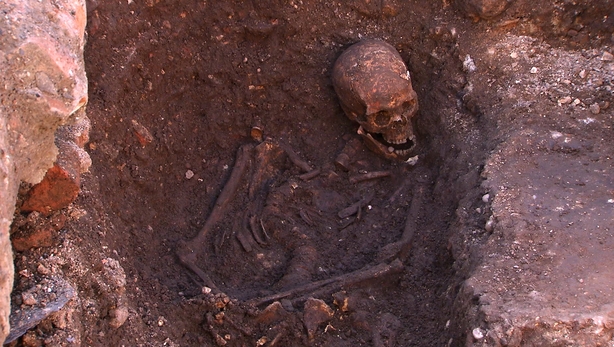Queen Elizabeth II has praised the reburial of Richard III, saying Britain had recognised a moment of "great national significance" was at hand.
In a moving service 530 years after Richard's death at Bosworth Field, the king's remains were re-interred at Leicester Cathedral today, witnessed by descendants of that battle.
In front of 700 people, including actors Benedict Cumberbatch and Robert Lindsay, who had both played the much-maligned king in Shakespeare, an army guard of honour bore the king aloft to his final resting place.
There, in the ambulatory of the 800-year-old cathedral site, presided over by the Archbishop of Canterbury Justin Welby, the golden-coloured oak coffin was carefully lowered into place.
It marked the end of a remarkable journey which had seen the king lying in a forgotten and unremarkable grave for more than five centuries before being found under a council car park .

In a foreword to the order of service, the queen said she recognised the "great national and international significance" of Richard's reburial.
"Today, we recognise a king who lived through turbulent times and whose Christian faith sustained him in life and death," she said.
She expressed her wish that Richard, slain at 32 in August 1485, would "now lie in peace in the city of Leicester in the heart of England".
The final chapter of the Plantagenet king's story unfolded in a solemn and reflective service, and the Countess of Wessex, attending alongside with the Duke and Duchess of Gloucester, was among many wearing black.
Watching the extraordinary events from the pews were other dignitaries including author Philippa Gregory, the writer of Downton Abbey Julian Fellowes and broadcaster John Sergeant.
Also watching was Philippa Langley, who had campaigned for years to mount a dig in the spot where the old king was eventually discovered by University of Leicester archaeologists.
The coffin had lain in repose inside the cathedral since a procession on Monday, attended by 35,000 people, through Leicester and its surrounding countryside.
Now to be reburied, a seven-man guard of honour drawn from successor Army regiments of units which fought at Bosworth smoothly lifted the 110kg coffin and unflinchingly bore their burden throughout the lengthy eulogy.
Professor Gordon Campbell of the University of Leicester spoke of Richard's upbringing, his life, adding the "adverse judgement" levelled at Richard, most notably over the fate of his two nephews, the Princes in the Tower, had recently changed.
He said: "Richard III has the greatest following of all English monarchs, apart from our present queen".
The coffin was then borne to a plinth near the cathedral's holiest place, the high altar, led by the archbishop.
The Very Rev David Monteith, the Dean of Leicester, then addressed those present from the pulpit, telling them "today we are committing his mortal remains to consecrated ground in the cathedral".
The king's own prayer book, the Book of Hours, was then placed atop the king's coffin, itself already covered with a small square of burgundy and royal blue cloth, and a wreath made by the villagers of Sutton Cheney from near the old battlefield.
The Bishop of Leicester, the Rt Rev Tim Stevens then delivered his sermon for the last Yorkist king who, he said, seemed to have "stepped from the pages of history into the fullest glare of the world's attention".
He said the world had been captivated by Richard's story, sparked by the "astonishing discovery" of his remains in the ruins of Greyfriars church long lost under a council car park.
"Whether we are Ricardians or Shakespeareans, whether we see through the eyes of Olivier, McKellen or Cumberbatch, whether we recognise a warrior or a scholarly pious thinker, today we come to accord this King, this child of God, and these mortal remains, the dignity and honour denied them in death," he said.
But in a message for the here and now and referring to what the queen had called those "turbulent times", the Wars of the Roses, he warned against division in society.
He said: "500 years after the Wars of the Roses we still face the risk of damaging tribal behaviours, of the destructive instincts which can so quickly turn neighbours into strangers and corrode our sense of the common good."
Richard was then carried into the cathedral's ambulatory and there to the open space of his tomb, between the altar and the New Chapel of Christ the King, only 25m from the cramped and hastily-dug grave under the car park where he had been found in August 2012.
There, witnessed by the royal party, the Archbishop cast holy water and incense over the coffin.
The Archbishop said: "Whether we bear a white or a red rose, whether for Richard or Henry, whether for Stanley or Howard, whether for Leicester or York, we recognise at the graveside that all our journeys lead us to this place where reputation counts for nothing and all human striving falls to dust."
In the final act of his journey, Richard's coffin was lowered into the tomb of Swaledale Yorkshire stone and, as it was, soil from the places of his birth, his life and his death were scattered over.
"Earth to earth, ashes to ashes, dust to dust," said the Archbishop.
The tone of the service then became celebratory, heralded by a lone trumpeter from the cathedral balcony and taken up by the faultless voices of the choir led by the director of cathedral music Dr Christopher Ouvry-Johns.
Mr Cumberbatch - himself a distant cousin of Richard's - read a specially-commissioned 14-line poem by poet laureate Carol Ann Duffy.
"Grant me the carving of my name," he read. "These relics, bless."
Afterwards, Ms Langley said she was "exhausted" but the events of this week had been "a long time coming".
"The history books will now need re-writing," she said. "We now know where King Richard is buried."

